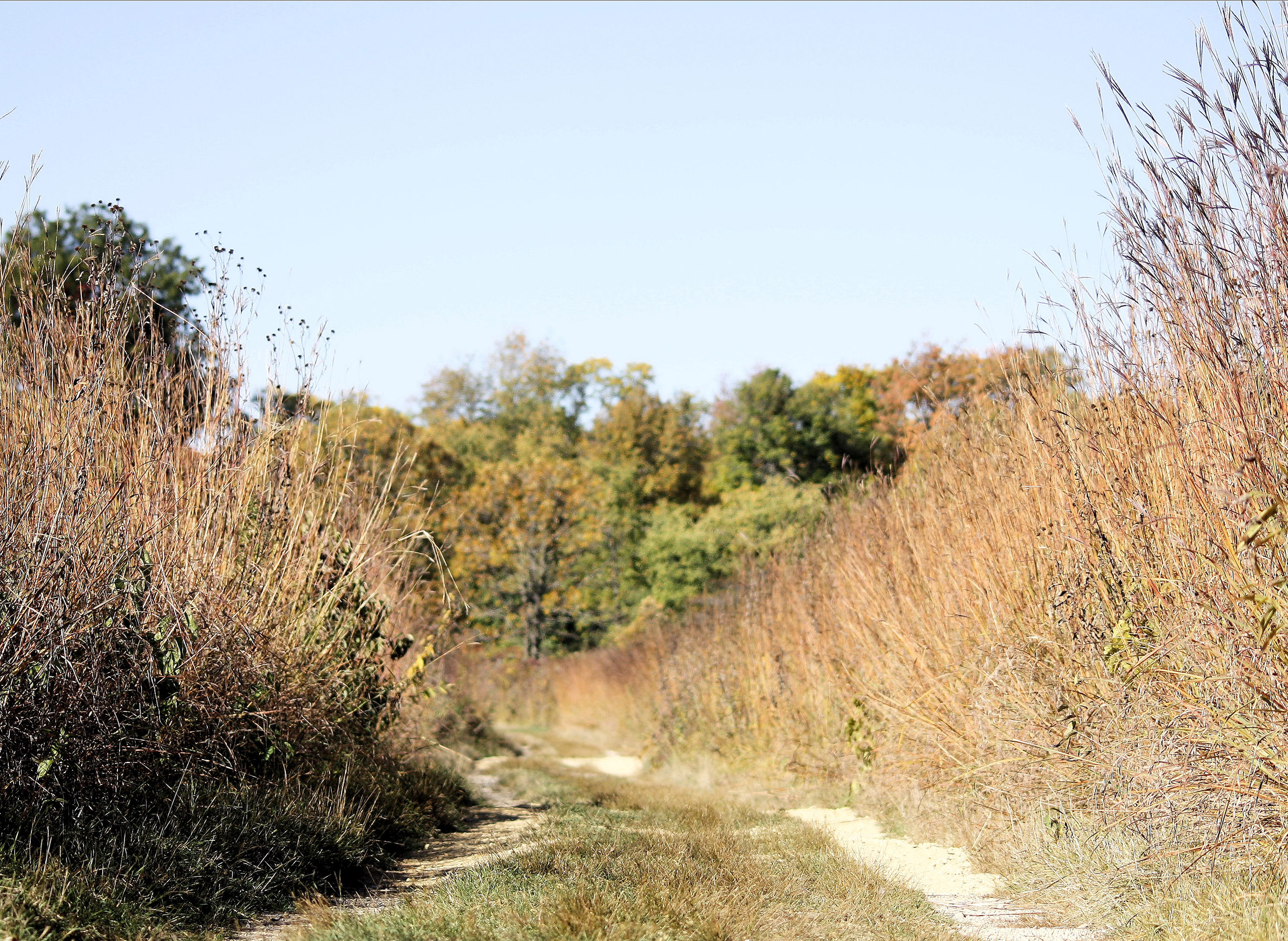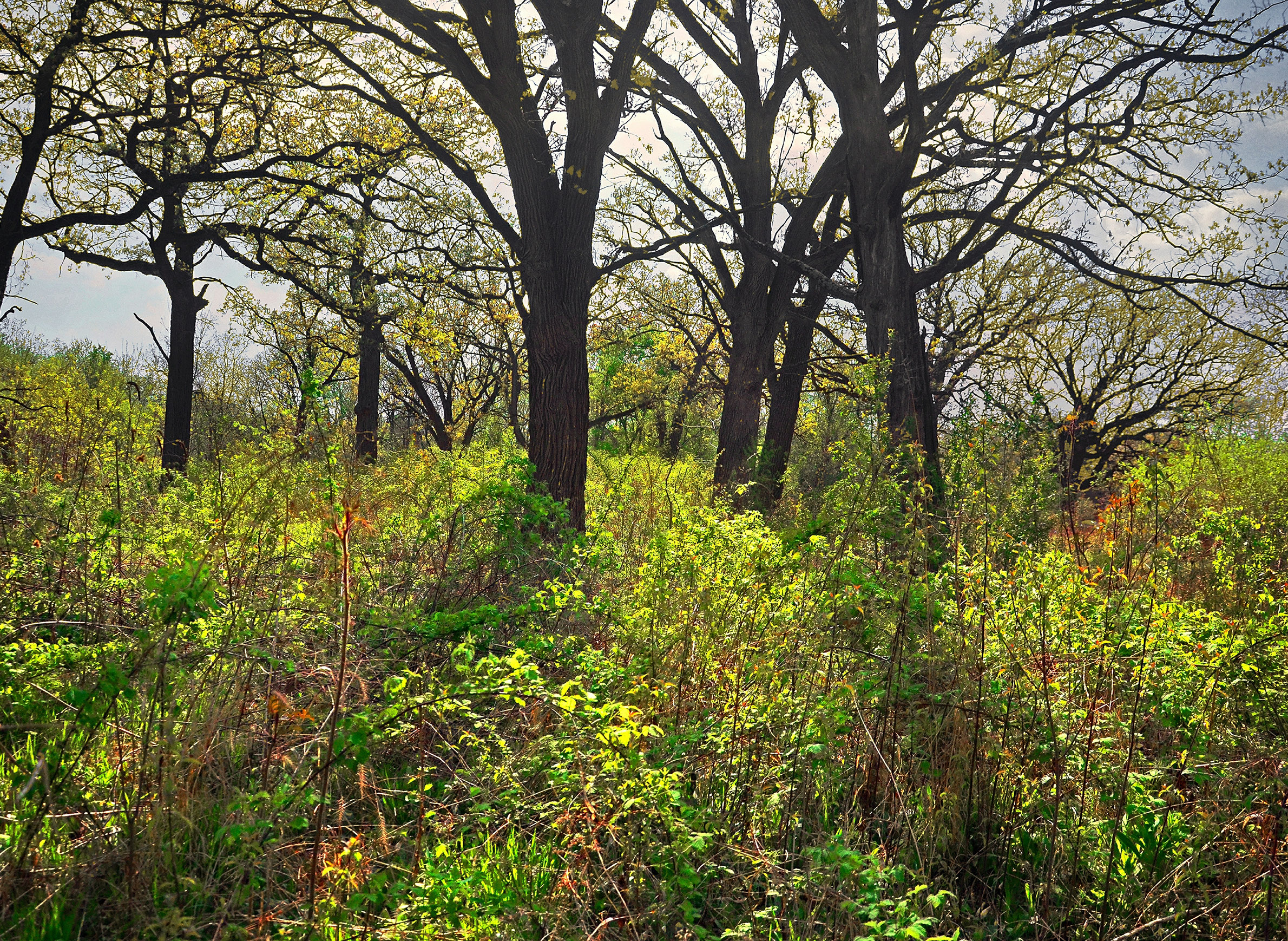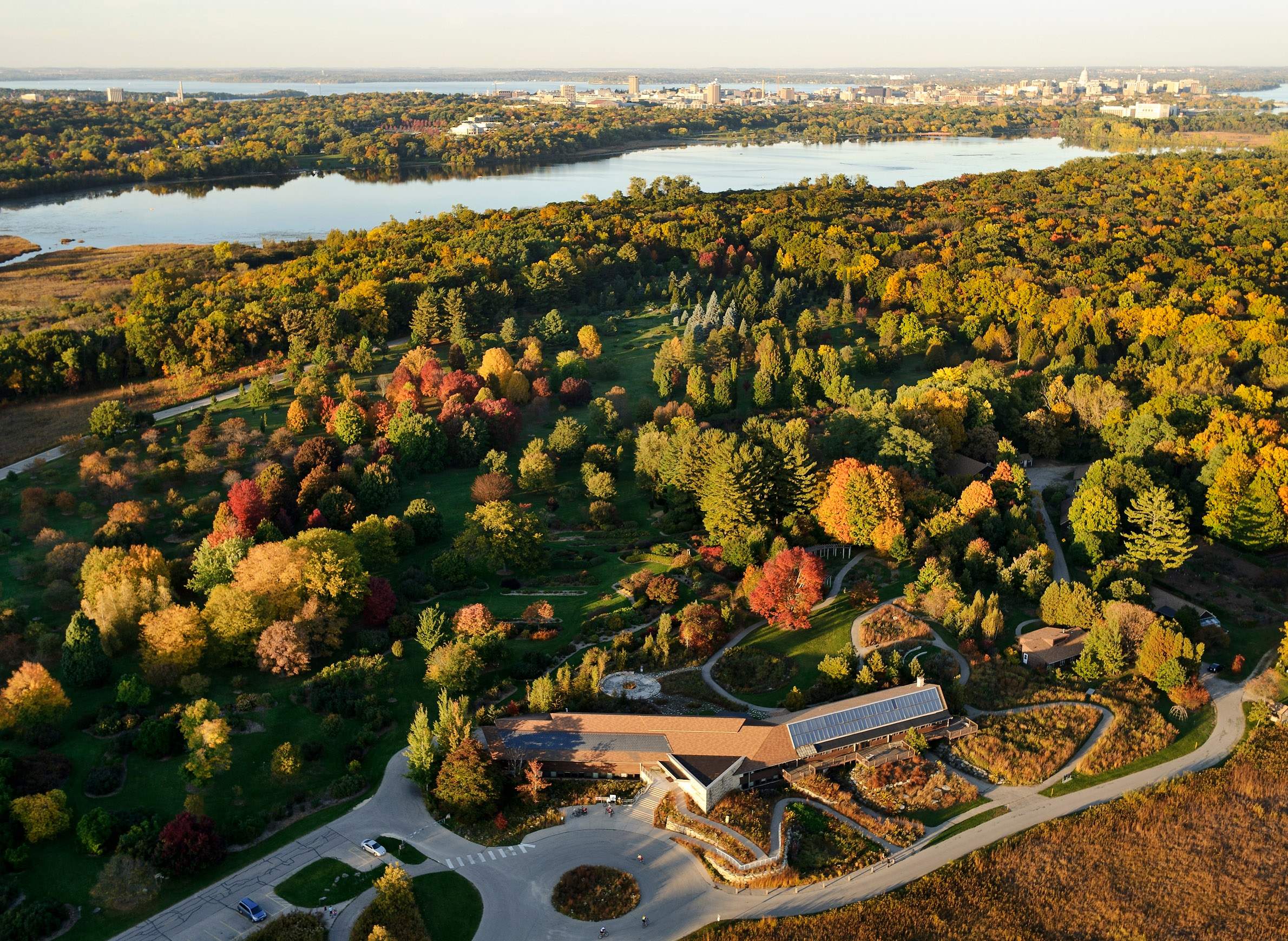Wisconsinites know the University of Wisconsin-Madison Arboretum as a contemplative place to visit a plethora of gardens, prairies and forests — 1,200 acres of the Wisconsin Idea bordered by Lake Wingra to the north and sprawling urban development in other directions. But the botanists and ecologists who created it were thinking more about rigorous scientific research and teaching — and above all, insights into how to restore ravaged environments — than they were about providing a naturalistic refuge for the public.
In the 21st century, nearly a century after its founding in the 1930s, the institution balances Wisconsin’s tradition of ecological research with public outreach, citizen-science projects, and hosting visitors, whether they want to learn more about prairie ecosystems or just enjoy the scenery.
News with a little more humanity
WPR’s “Wisconsin Today” newsletter keeps you connected to the state you love without feeling overwhelmed. No paywall. No agenda. No corporate filter.
Established on what was previously farmland, the Arboretum was initially a place to study the inner workings of Wisconsin’s prairies and recapture what the area’s landscape looked like before European settlement. Over time, it grew to reflect plants and ecosystems from across the state.
Brad Herrick, an ecologist and research program manager at the UW Arboretum, offered an introduction to its history and evolving mission in a July 3, 2018 talk for the Wednesday Nite @ the Lab series on the UW-Madison campus. In the talk, recorded for Wisconsin Public Television’s “University Place,” he recalled the scientists who conceived of and launched the project, as well as the forces, both human and natural, that have shaped it ever since.
Wisconsin’s renowned early naturalist and scientist Increase Lapham first conceived of the idea of a university arboretum focused on native plants in 1853. However, the UW didn’t actually begin purchasing land until 1932. The next year, horticulturist William Longenecker was hired as ant executive director, and Aldo Leopold, then a professor of wildlife ecology at UW-Madison, was made research director. The UW Arboretum was officially dedicated on June 17, 1934.
Curtis Prairie is the oldest restored prairie at the Arboretum. It was the site of much of the early research in ecological restoration that still shapes the institution’s mission today.
“It’s the oldest restoration in the world because it’s still ongoing,” said Herrick, of the Curtis Prairie. “It’s constantly changing and we’re constantly having to pull invasive species every year to make sure that it stays a high-quality prairie.”
Norman Fassett, UW-Madison botany professor, conducted the first major research projects on what would later come to be named Curtis Prairie in the mid-1930s, experimenting with planting native grasses on the parcel of land. With help from a student named John Thomson, Fassett gathered sod and seed from across southern and western Wisconsin, transplanted them to the Arboretum and tracked their progress. After a year of research, they concluded that plants from a sandy prairie in Spring Green had the best success rates in their new home.
Ted Sperry, the Arboretum’s first ecologist, was hired in 1936. One of the first prairie ecologists in the United States, he stepped up efforts to reestablish prairies, building on the lessons of Fassett and Thomson’s experiments.
The prairie is named for John Curtis, a botanist and Waukesha native who started working at the Arboretum in 1941 and served as UW-Madison’s plant research director for 20 years. Curtis and a student, Max Partch, published an influential paper in the late ’40s that examined how fire impacts the competition between bluegrass species and certain prairie plants. They found that burning cut down on the prominence of Kentucky bluegrass and Canada bluegrass and allowed native prairie plants to spread. Prescribed fires are still an important tool in the Arboretum’s management practices.
UW-Madison mycologist and botanist Henry Greene conducted extensive studies of the fungi species in the Arboretum. He collaborated with Curtis on research into the germination of prairie plants. This work helped to establish many of the finer technical points of planting a native prairie and ensuring its survival, from battling weeds to fostering the right soil conditions for native grasses.
Virginia Kline served as the Arboretum’s head ecologist from 1975 to 1996 and conducted research on incursions into the Curtis Prairie by the invasive white sweetclover. Kline figured out that controlled burning in the spring was conducive to the sweetclover’s biennial life cycle, setting back the growth of the plants but leaving them alive to seed later in the season. She implemented a new approach, waiting to conduct burns until after the sweetclovers had bloomed, which killed the plants before they were able to release seeds.
As the UW Arboretum entered the 21st century, Joy Zedler served as its research director for 18 years. Extending investigations into the role of invasive plants, she focused on why these species move in and how to restore the ecosystems they’ve affected, sometimes by harnessing the unique capabilities of native plants to make those ecosystems more resilient.
In recent years, researchers are renewing their focus on plants and ecosystems native to the Dane County area. One reason is related to ecological issues like attempts to recreate habitats like a northern Wisconsin boreal forest in the southern part of the state will inevitably be incomplete, and draw in invasive species like buckthorn and honeysuckle. Additionally, not all of the ecosystems represented in the Arboretum would naturally border each other, so researchers are placing more emphasis on ecosystems that flow together — for instance, a prairie next to an oak savanna.
Contemporary research at the UW Arboretum also extends beyond botany and plant ecology. Recent projects include a study of ticks led by UW-Madison entomologist Susan Paskewitz, and the UW Urban Canid Project, which studies coyotes and foxes in the restored landscapes and surrounding cityscape. The Wisconsin Department of Natural Resources is studying Wisconsin’s bats, frogs and toads there. And Karen Oberhauser, the Arboretum’s current director and renowned monarch butterfly biologist, studies the butterflies’ migrations in projects that involve citizen science.
“For a long, long time, we were doing plant ecology research,” said Herrick. “We have a really strong botanical, plant ecology background, and that’s great and we will all continue that. But we also want to do more work with wildlife, with citizen science.”
Key facts
- The main grounds of the UW Arboretum comprise about 1,200 acres of woodlands, oak savanna, prairie, and wetland. Arboretum staff and researchers also manage an additional 500 acres of land scattered across southern Wisconsin.
- Between 1935 and 1941, workers with the Civilian Conservation Corps, a New Deal program, helped develop the UW Arboretum.
- The land ethic, as articulated by Aldo Leopold, helps guide the UW Arboretum’s work. It encourages people to think of themselves as part of the landscape in a holistic way.
- One of Aldo Leopold’s innovations was to showcase not just individual plant specimens from around the state, but to place them in “ecological groupings” that emulated their naturally occurring ecosystems, including the boreal forests, cedar glades and pine barrens of northern Wisconsin. He also wanted part of the UW Arboretum to capture what Dane County looked like before European settlement, which was primarily oak savanna with some marshland.
- Part of Curtis Prairie is considered a remnant of a naturally occurring prairie. Much of the land around it was farmed, but areas of what became the prairie were not considered very good farmland. Farmers at most used these areas for mowing hay and grazing livestock, but this land was left fallow for at least a decade before the university bought the land.
- The plants Ted Sperry raised in his pioneering prairie ecology projects included big bluestem grass (Andropogon gerardi), little bluestem grass (Schizachyrium scoparium), wild indigo (Baptisia australis), and prairie junegrass (Koeleria macrantha). Methods of seeding and sodding directly into the prairie seemed to work best, as plants started in a greenhouse and later transplanted didn’t survive as often.
- Henry Greene created the UW Arboretum’s 50-acre Greene Prairie, which has drier soils than Curtis Prairie and benefited from his intricate understanding of hydrology and where specific kinds of plants should go depending on their water and soil needs.
- Since the 1950s, the UW Arboretum has conducted an ongoing study of forest succession in its Noe Woods section, looking into what happens to a forest in the absence of fire.
- Joy Zedler established the Mesocosm Facility, a controlled experimental site within the UW Arboretum. Zedler also led the creation of a series of more than 40 leaflets aimed at explaining research to the public in approachable, non-technical terms, including one about mesocosms.
- Historically, the UW Arboretum has had distinct management plans for different sections, but now staff and researchers are working to manage it on a “watershed scale,” or thinking more holistically about the Arboretum and the surrounding landscape. In the 21st century, Arboretum researchers and staff have had to adapt their management practices to respond to the challenges of climate change, stormwater runoff, and invasive species including the emerald ash borer and garlic mustard.
- Since the 1930s, the once-agricultural lands surrounding the UW Arboretum have become home to extensive urban development, including Madison’s Beltline highway, which cuts through its southwestern portion. (The 2013 book “Pioneers of Ecological Restoration: The People and Legacy of the University of Wisconsin’s Arboretum” details the Arboretum’s history, and an April 2018 issue of Madison weekly newspaper Isthmus explored its contemporary landscape.)
Key quotes
- On Aldo Leopold’s initial vision for the UW Arboretum’s use: “It’ll be done for research, not for the amusement of the town. It’ll be for the university rather than for use by the public, basically. He was a research scientist, a field ecologist, and he felt that this place should be a place for experimentation, for teaching, for learning, and didn’t want the public meddling in all of this. He wanted it to be sort of a beside-the-preserve kind of ecological station, if you will, to do research for the university. And, obviously, that has changed over the years … We are a research center, but we welcome and encourage the public to come. And so there’s, you know, sometimes balancing those two goals can be challenging, but they’re both really important to what we do.”
- On the concept of the land ethic: “What this is saying is as humans we need to think of ourselves as part of the landscape, not separate from it, not, you know, sort of over it and utilizing it for our purposes. But if we think of ourselves as part of the landscape, then we’ll respect it more. So this is sort of how we think of our education and our outreach objective is to follow the land ethic and teach that.”
- On the initial value of recreating ecosystems from around the state: “If you think about the 1920s, 1930s, it was really hard for people to get up northern Wisconsin and see a boreal forest, for example, or a real intact pine stand. It was hard for students to access those kinds of communities. But the idea was let’s bring them to campus here.”
- On the juxtaposition of different kinds of ecosystems within the UW Arboretum and why it’s a problem: “A lot of these plantings, like the pine plantings are planted next to Curtis Prairie. They’re called Leopold pines, so we don’t want to get rid of them. But they make this artificial boundary that you wouldn’t find in nature. You wouldn’t find a pine forest next to an open prairie all the sudden. You would find more of a gradient between those two systems.”
- On the UW Arboretum’s relationship with its urban surroundings: “The Arboretum is really nestled in the city of Madison; it’s a very urban area. It’s a green space and an urban area. Even the Beltline actually dissects the Arboretum. There’s a 200-acre parcel here … called the Grady Tract. That used to be connected to the Arboretum, but in the ’50s, when that Beltline went in, it went right through. And so we lost some pines and had some increased fragmentation there. So a lot of our restoration and our research kind of is either informed or tries to answer questions about how urbanization affects the landscape.”
A Living Legacy Of Research At The UW Arboretum was originally published on WisContext which produced the article in a partnership between Wisconsin Public Radio, Wisconsin Public Television and Cooperative Extension.
This report was produced in a partnership between Wisconsin Public Radio, PBS Wisconsin and the University of Wisconsin Cooperative Extension. @ Copyright 2025, Board of Regents of the University of Wisconsin System and Wisconsin Educational Communications Board.








